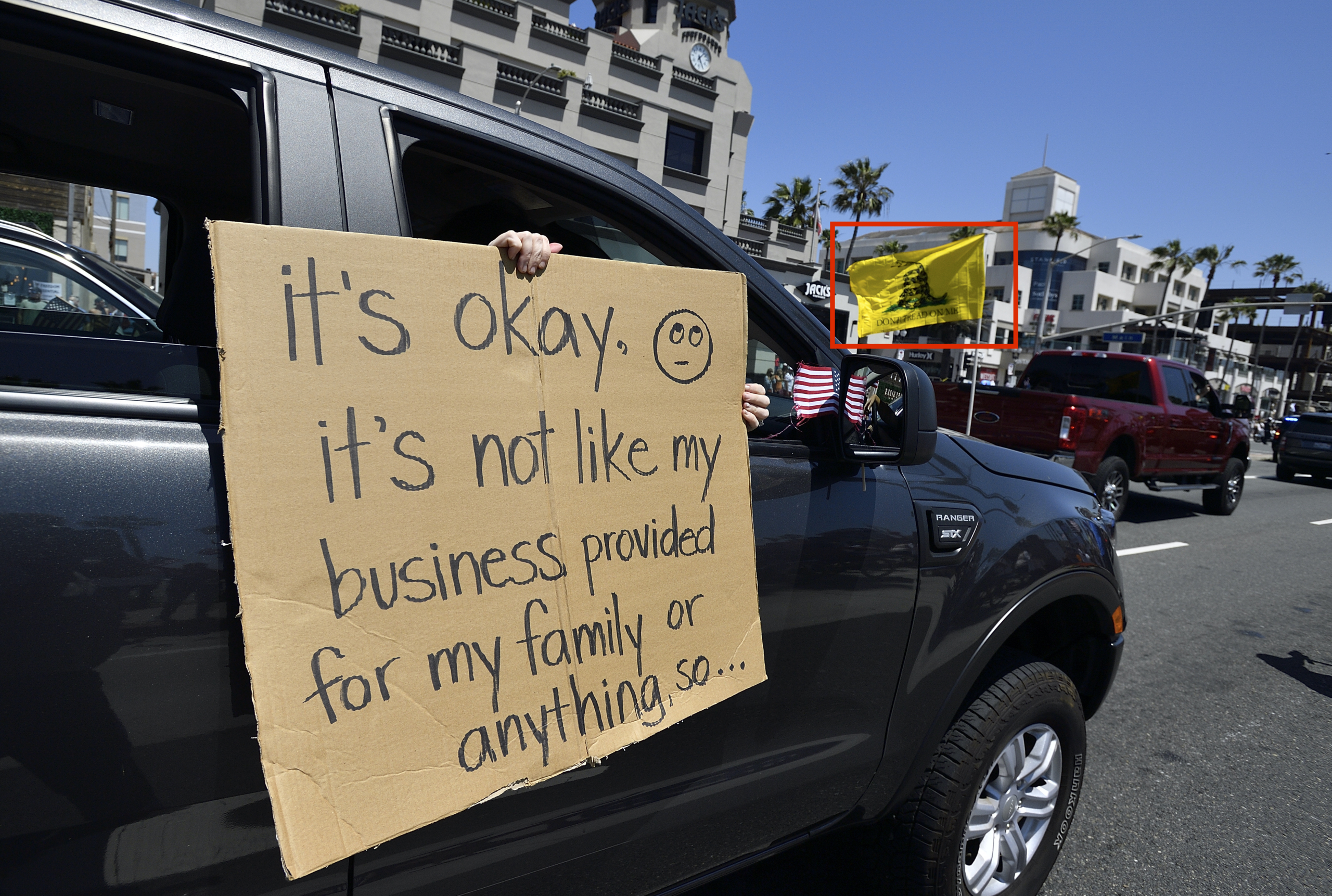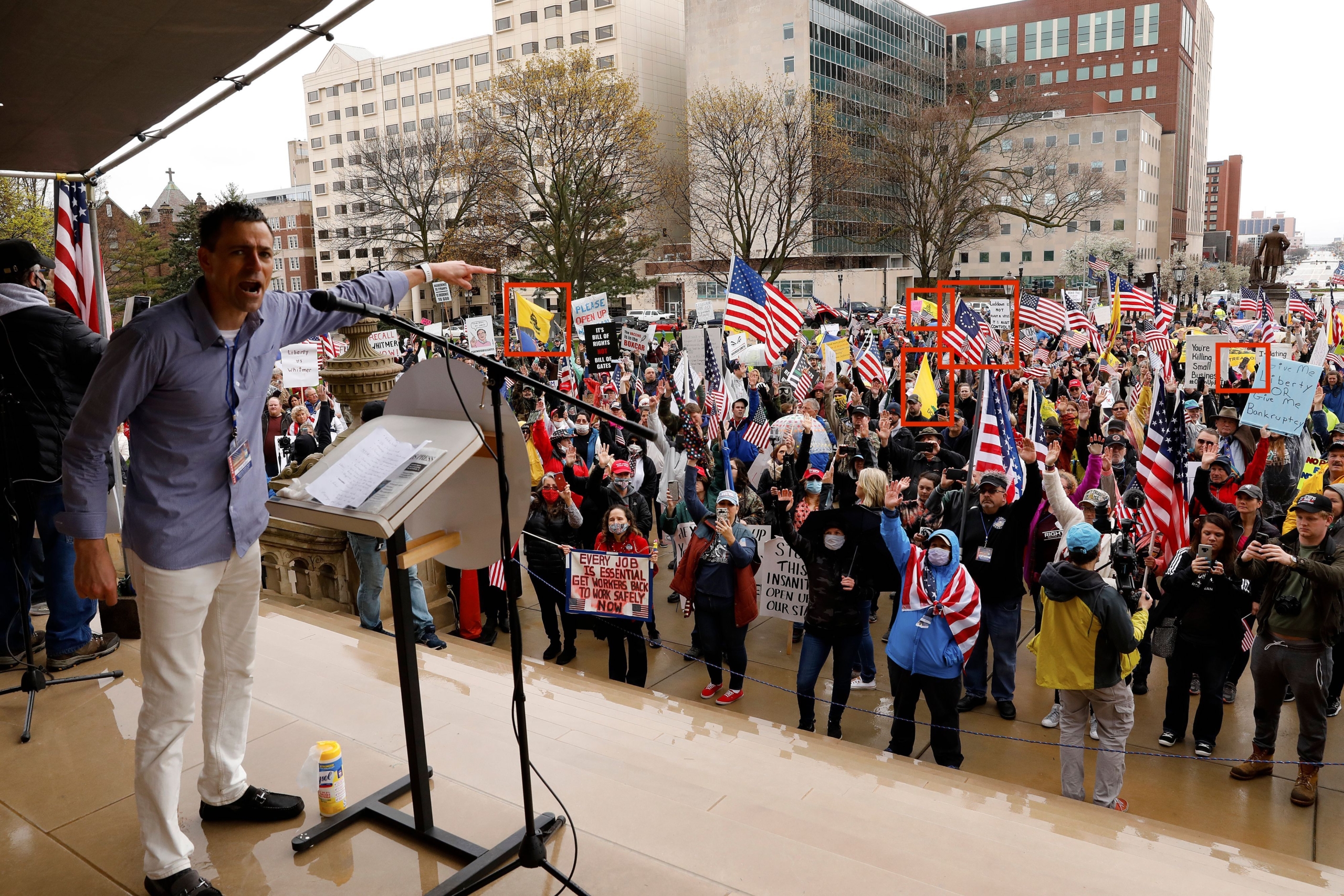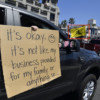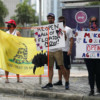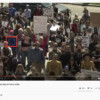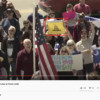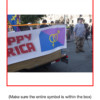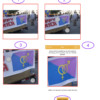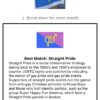Sign up for The Media Today, CJR’s daily newsletter.
In recent weeks, the United States has seen two distinct waves of protests. In April and early May, so-called “Reopen America” protests expressed opposition to COVID-19 lockdown measures in many states. Currently, demonstrators across the country are protesting against anti-black police brutality, in response to the killing of George Floyd by white police officer Derek Chauvin in Minneapolis. Researchers at the Tow Center and Columbia’s Journalism and Engineering schools have developed a tool that can help reporters decipher the symbols and acronyms used by political groups which may be helpful as they report on political actions now and during the election season.
Reopen Protests
As photographers documented the “Reopen America” anti-lockdown protests in many cities across the country, symbols common across protests began emerging:
In these photos, I have highlighted two flags in particular: the Gadsden flag and the Betsy Ross flag.
What makes these flags so prevalent at the protests? The New York Times and The Washington Post have found links between the protests and large Republican donors, while research by the Tech Transparency Project (TTP) and the Institute for Research & Education on Human Rights (IREHR) found links between “Reopen” protests and movements to mobilize and arm libertarian extremists during the coronavirus lockdown to start a civil war.
A document TTP researchers found on multiple Facebook groups related to preparing for the “Boogaloo” (the term used to denote the supposedly impending civil war) offers some clues as to why these flags may be so abundant at the protests.
“Imagery is important to a revolution,” the document says. It goes on to exhort supporters of the movement to use “the Gadsden, Colonial US and the “Come And Take It” flags in their demonstrations. The Gadsden and Betsy Ross flags gained prominence during the United States’ Revolutionary War. The 13 stars of the Betsy Ross Flag represent the US’s 13 colonies at the time. These flags have been appropriated by libertarian and extreme right groups, and often appear at demonstrations nominally about protecting American citizens’ second amendment rights. Though it must be noted that not all people who use these flags are associated with extremist movements.
Knowledge of the context and associations of these symbols could be very helpful to a reporter as they prepare to interview a demonstrator.
The value of using symbols to gain immediate context for an interview or photo at a demonstration, occurred to photojournalist and Columbia Professor Nina Berman at the Unite the Right 2 rally in Washington, D.C., in 2018.
Her insights have led a team comprising researchers at Columbia’s School of Engineering, researchers at the Tow Center and Berman herself to build an app, called VizPol, to identify political symbols in real-time. The app has a simple user experience: a user uploads an image containing a symbol they are interested in identifying, and if the symbol is in the app’s database, the app identifies it, and provides the user with some context about it. If the app fails to recognize the symbol, the user has the option of sending us the image of the symbol so that we can examine it and add it to the app’s database.
In the examples above, I have pointed out relatively well-known symbols. But we’ve seen protesters at demonstrations use a wide variety of less recognizable symbols, each one denoting a different, often far-right group or ideology. Here are some more examples, taken purely from Reopen protests. Most of these symbols can be identified by our app, and we are working on adding the ones that can’t to its recognition database:
Also at yesterday's ReOpen Kansas rally in Topeka, this guy wearing his AltRight "KEK" sweatshirt pic.twitter.com/psgc35W4be
— Devin Burghart (@dburghart) April 24, 2020
On this man’s t-shirt we see the “KEK” symbol.  This symbol is part of the larger “Kekistan” flag. The flag, modeled after the German Nazi War flag with “kek” replacing the swastika, represents the fictional country of Kekistan created by 4 chan members as an online political meme that gravitated to the real world (The 4 chan logo is seen in the upper left corner). Members of the alt-right use the flag and its symbol to ridicule identity politics and troll social justice progressives by claiming that “kekistanis” are an oppressed ethnicity.
This symbol is part of the larger “Kekistan” flag. The flag, modeled after the German Nazi War flag with “kek” replacing the swastika, represents the fictional country of Kekistan created by 4 chan members as an online political meme that gravitated to the real world (The 4 chan logo is seen in the upper left corner). Members of the alt-right use the flag and its symbol to ridicule identity politics and troll social justice progressives by claiming that “kekistanis” are an oppressed ethnicity.
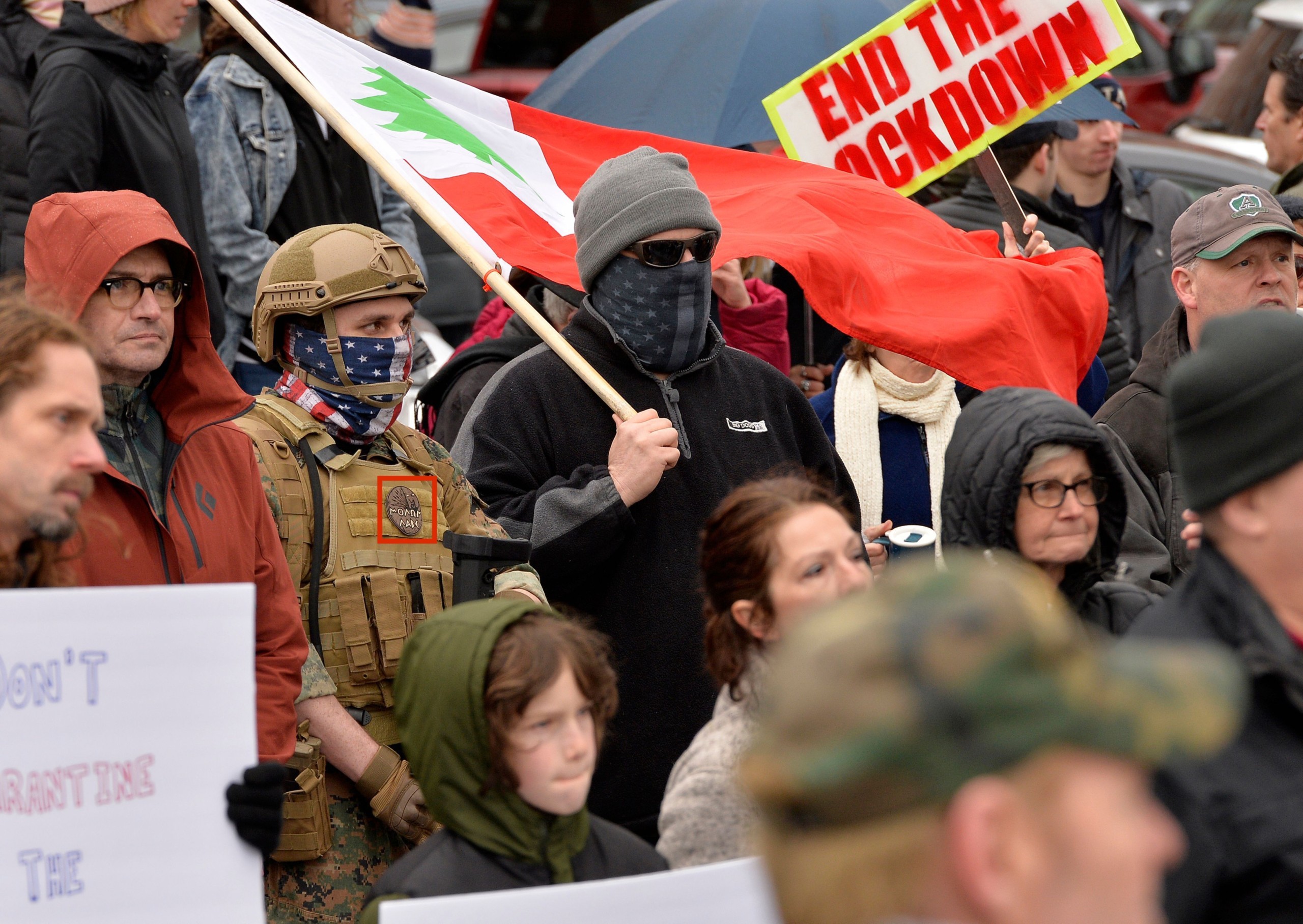
Hundreds of New Hampshire residents rally at the State House, calling on the government to re-open the state for business as the coronavirus shutdown continues, in Concord, New Hampshire, on April 18, 2020. (Photo by Joseph Prezioso / AFP) (Photo by JOSEPH PREZIOSO/AFP via Getty Images)
 The words spell “Molon Labe”, Ancient Greek for “Come and Take [Them]”. This epigram, used by Spartan King Leonidas in 480 BC to defy the Persian King Xerxes’ demand that he lay down his arms, has been appropriated by gun-rights groups. It could also be related to the Texan Come and Take It flag (also referenced in the document found by TTP above), though, like the historic flags discussed above, many people, especially those entirely unaffiliated with extremist movements, use this flag.
The words spell “Molon Labe”, Ancient Greek for “Come and Take [Them]”. This epigram, used by Spartan King Leonidas in 480 BC to defy the Persian King Xerxes’ demand that he lay down his arms, has been appropriated by gun-rights groups. It could also be related to the Texan Come and Take It flag (also referenced in the document found by TTP above), though, like the historic flags discussed above, many people, especially those entirely unaffiliated with extremist movements, use this flag.
However, that these flags don’t automatically denote extremism is often a convenient excuse for real extremists. Often, the words Molon Labe are seen under a cartoon Spartan helmet:
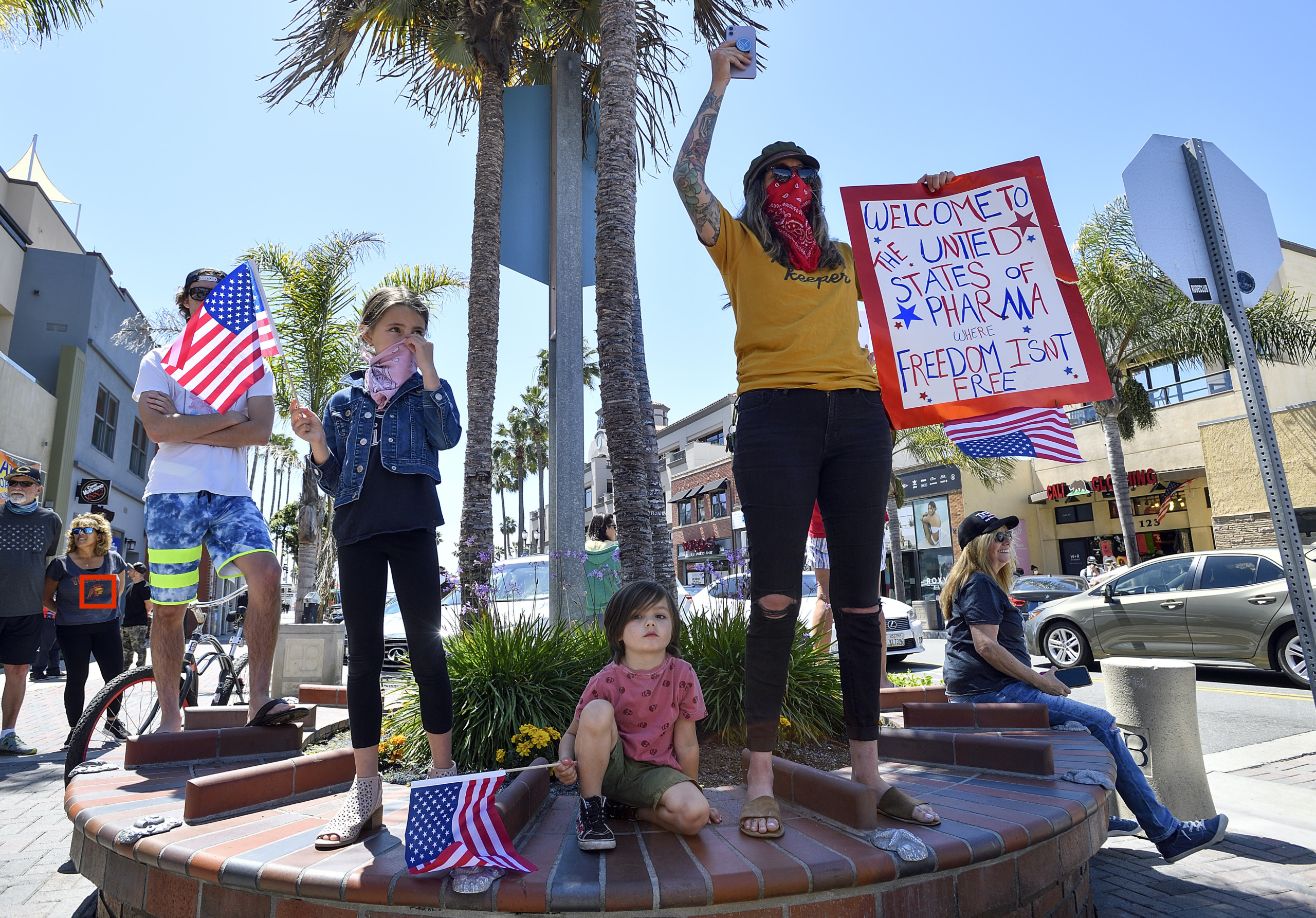
HUNTINGTON BEACH, CA – APRIL 17: Jessica Lilly, right, with her children, Abbey Lilly, 7, and Arlo Lilly, 4, join a crowd of people gathered at the corner of Main Street and Walnut Avenue in Huntington Beach, CA, to protest coronavirus (COVID-19) closures on Friday, April 17, 2020. (Photo by Jeff Gritchen/MediaNews Group/Orange County Register via Getty Images)
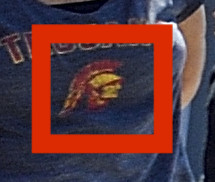 Since Huntington Beach is just a few miles from the University of Southern California, this is most likely just a USC Trojans t-shirt without any sinister meaning. But given that hiding behind mundane symbols or mundane interpretations of symbols is a common technique used by extremists, it is possible that this woman wore the USC Trojans t-shirt deliberately because the USC Trojan symbol looks like the animated Spartan character from other “Molon Labe” symbology. This highlights the most important rule of thumb to keep in mind when using the VizPol app—the app can never give context about the symbol users’ intent. That is entirely incumbent upon the reporter to determine.
Since Huntington Beach is just a few miles from the University of Southern California, this is most likely just a USC Trojans t-shirt without any sinister meaning. But given that hiding behind mundane symbols or mundane interpretations of symbols is a common technique used by extremists, it is possible that this woman wore the USC Trojans t-shirt deliberately because the USC Trojan symbol looks like the animated Spartan character from other “Molon Labe” symbology. This highlights the most important rule of thumb to keep in mind when using the VizPol app—the app can never give context about the symbol users’ intent. That is entirely incumbent upon the reporter to determine.
In this image from Austin, we can see a demonstrator wearing a Guy Fawkes mask:
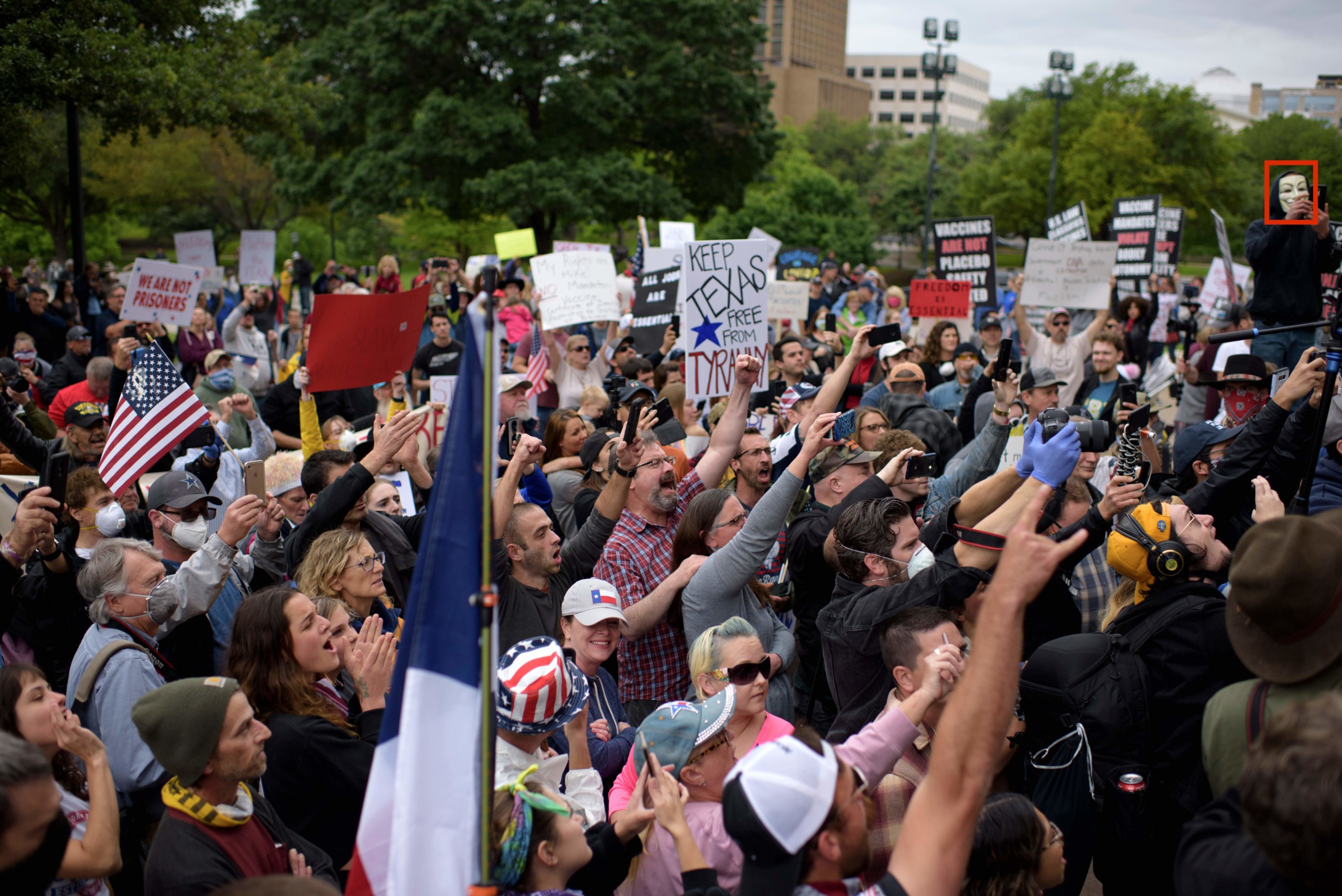
Protesters yell in unison when Infowars owner Alex Jones arrives to the “Reopen America” rally on April 18, 2020 at the State Capitol in Austin, Texas. (Photo by Mark Felix / AFP) (Photo by MARK FELIX/AFP /AFP via Getty Images)
 One group that uses Guy Fawkes masks, Anonymous, is a decentralized international online “hacktivist” community known for cyberattacks against various governments, institutions and corporations. Their actions have broadly been against censorship and government control, but critics have labeled them cyber terrorists. Protesters around the world show solidarity with the Anonymous movement by wearing the masks. More recently, devotees of the far-right conspiracy movement Qanon have begun to use the symbol of the mask as well.
One group that uses Guy Fawkes masks, Anonymous, is a decentralized international online “hacktivist” community known for cyberattacks against various governments, institutions and corporations. Their actions have broadly been against censorship and government control, but critics have labeled them cyber terrorists. Protesters around the world show solidarity with the Anonymous movement by wearing the masks. More recently, devotees of the far-right conspiracy movement Qanon have begun to use the symbol of the mask as well.
This video from Lansing features this modified US flag, similar to the most common modification to the US flag at political protests, the “Blue Lives Matter” or “thin blue line” flag:
Chants of “recall Whitmer,” “USA” and “lock her up” outside Michigan Capitol. #OperationGridlock pic.twitter.com/7Q7niiNFUF
— Malachi Barrett (@PolarBarrett) April 15, 2020
Blue Lives Matter is a national movement advocating that those who are convicted of killing law enforcement officers should be sentenced under hate crime statutes. The movement’s other goal is to counter media coverage perceived to be anti-police. The name responds to the Black Lives Matter movement, which seeks police accountability in the killing and harassment of people of color.
Similarly, movements related to other law enforcement bodies are represented by replacing one stripe of a regular or grayscale US flag with a stripe of a different color. Blue denotes police, green denotes Federal Agents such as Border Patrol, Park Rangers etc., orange denotes Search and Rescue personnel, and so on.
Other research conducted by the IREHR has also documented the presence of members of the neo-fascist, misogynistic Proud Boys at various Reopen rallies.
Symbols associated with extremist political groups, much like the groups themselves, are constantly evolving. The app’s database began with 52 symbols seen at rallies prior to mid-2019, but we have already identified symbols associated with new groups since then. One such group also affiliated with the “Boogaloo” movement discussed above, Patriot Wave, was seen at the January 20th Gun Rally in Richmond, Virginia.
Many of these symbols originate online and make their way into the physical world on flags, patches, t-shirts, etc. like symbols used by so-called “Boogaloo Bois” and a militia-movement group calling themselves the Michigan Liberty Militia, which reporters saw at Reopen protests. Recent research by Bellingcat explains the significance of Hawaiian shirts, which are connected to the Boogaloo movement, at Reopen protests.
Protests Against Police Brutality
Minneapolis mayor Jacob Frey tweeted on Saturday, May 30th that white supremacists and other “outside instigators” were trying to destroy Minneapolis. Governor Tim Walz echoed this claim. However, officials in Minneapolis and St. Paul have offered little evidence of it, and have had to reduce their originally exaggerated estimates about the number of people arrested that were from out of Minnesota. Researchers studying far-right militia, one set of groups that these claims might refer to, warn that these groups often rely on the media and social media to amplify their presence at such rallies, while being less successful at actually organizing “offline”.
Meanwhile, President Trump and Attorney General William Barr have blamed violence on “far-left extremist groups using antifa-like tactics.” Trump even tweeted that he is going to designate “antifa” as a terrorist organization. This is misleading. The antifa movement is a network of autonomous groups who believe in opposing fascism by direct action and “antifa” refers to an assortment of tactics rather than any single organization. Neither Trump nor Barr has offered any evidence that members of antifa-aligned groups instigated violence that led to arrests anywhere.
Misinformation about white supremacists, militias and antifa groups’ participation in these protests is abundant. Identifying symbols that point to the political group a protester belongs to can help substantiate claims about individual people, and thereby help establish objective facts about who might be involved in demonstrations. Concrete information about such symbols can contextualize the actual impact of extremists, who often make up just a small minority of protesters. While the presence of members of the “Boogaloo” movement, discussed above, at these protests is exaggerated in some cases, Boogaloo symbols have certainly appeared at recent anti-police brutality protests, as documented by Vice and in this Twitter thread by Bellingcat researcher Robert Evans:
Oh boy I'm running into claims (https://t.co/29n75g8ugS) that the boogaloo boy with the flag was shot by a police rubber bullet. pic.twitter.com/7YLDYTJMQ4
— Robert Evans (The Only Robert Evans) (@IwriteOK) May 27, 2020
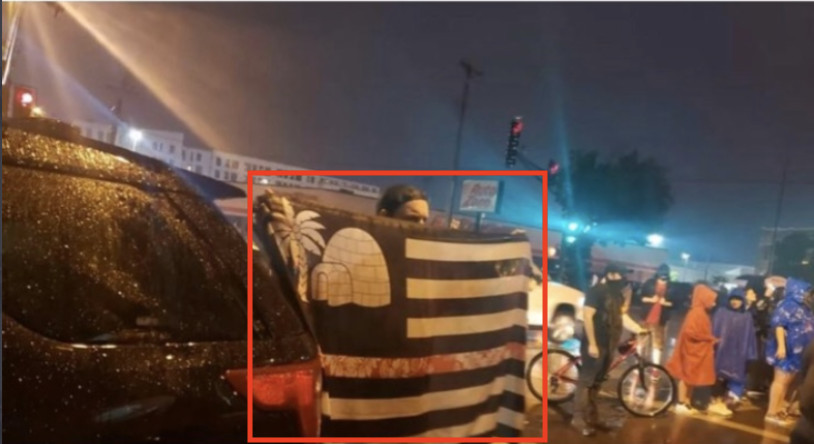
Boogaloo flag at Minneapolis protest from Robert Evans on Twitter
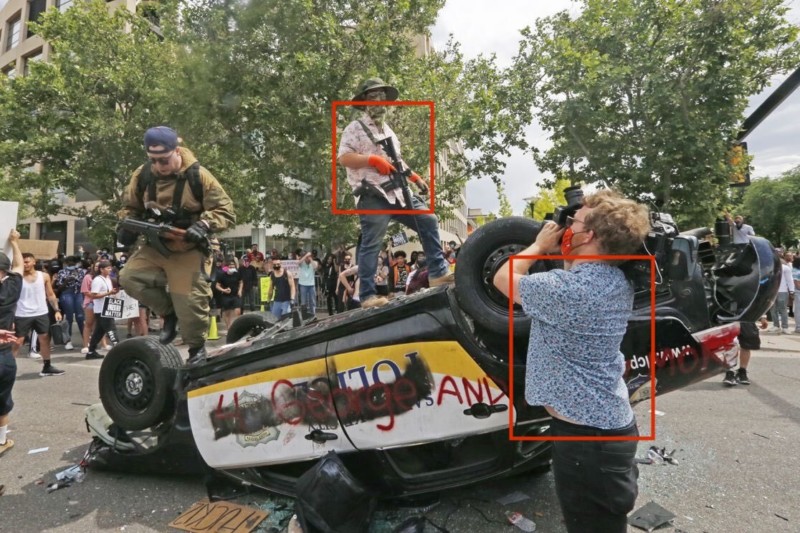
Possibly members of the “Boogaloo” movement, as evidenced by their Hawaiian shirts, in Utah from Twitter
The Bellingcat report referenced above, titled “The Boogaloo Movement Is Not What You Think”, suggests that a violent civil war is the ultimate goal of the Boogaloo movement. There is division within the movement about how bigoted and racist it should be. Many members are more focused on fomenting any kind of resistance to law enforcement, and even express a willingness online to ally with the current protests sparked by a white police officer killing a black man. This explains why “memes churned out [on Boogaloo groups added] George [Floyd] to the movement’s list of martyrs.” However, though they have rallied around opposition to police brutality on their online fora, members of the movement generally do not recognize police brutality as a scourge that specifically targets black people.
Antifascist researchers warn that right-wing and neo-Nazi groups, collectively referred to as “accelerationists” (accelerationists seek to “promote violence to speed up the collapse of society”) are gathering at these anti-police brutality protests to harm black protestors and spark a “race war.” They sometimes sport clown-related symbols. We are looking out for symbols associated with specific accelerationist groups. The Bellingcat report explains that Boogaloo fora are fertile recruiting ground for neo-Nazi groups, so it is possible that some people using Boogaloo symbols might be more accurately described as neo-Nazis or white supremacists rather than members of the Boogaloo movement as characterized above.
Other researchers have documented the presence of members of the Proud Boys at these protests:
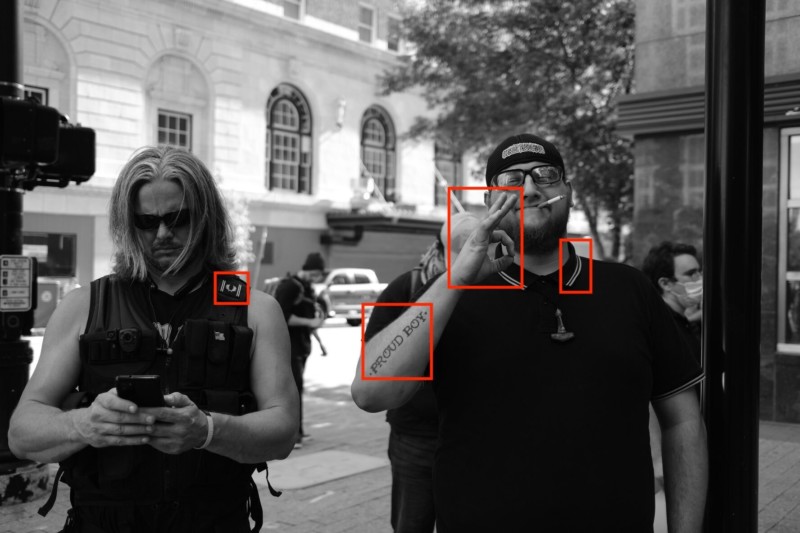
Proud Boys, identifiable by their tattoos, and Fred Perry outfits. The member of the Proud Boys on the right is flashing a “white power” hand gesture. Raleigh, North Carolina from Twitter
A central issue raised by these protests is that action must be taken against police officers that have white supremacist beliefs. UCLA social media scholar Sarah T. Roberts recently tweeted, “How many police orgs around the US have surveyed their officers for white supremacist tattoos, affiliations, clothing and symbol use? Comprehensively? And what were the findings? What actions were taken?”
https://twitter.com/chadloder/status/1266994073501487104
The above video from protests in New York show a police officer flashing the “Okay” hand gesture. It is entirely possible the officer was just signalling “okay” to someone off-screen, but it is also possible that he was deliberately signalling “white power.” Our app is able to identify and contextualize this hand gesture, but without talking to the police officer or looking for other contextual clues, the video of the gesture alone is not enough to establish whether this police officer holds white supremacist beliefs.
While we strongly resist applying the term “extremist” to members of antifa groups, the goal of our app is to help reporters on the ground identify groups at demonstrations in order to combat widespread misinformation about the demographics of protests and the motives of protesters. Therefore, our app can identify symbols associated with antifa groups as well. However, in our experience antifa groups employ more straightforward symbols than far-right extremists that require much less knowledge of obscure dog-whistles to decipher.
VizPol can only identify symbols and offer some context about these symbols. It is a tool for reporters to gain context before interviewing someone or analyzing a photo. A symbol on its own can be misleading and so it is incumbent upon the users of our app to use the context it provides to make any actual inferences about a person, their affiliation, and their motive at a rally.
Inviting Researchers to Use Our App
We understand that a team of researchers at a university, away from the field, will never be able to keep the database of symbols current, especially as these movements proliferate. Instead, we have endeavoured to create a method that, given a few examples of a new symbol, can then instantaneously identify it for reporters in the field. Our goal is to build a community of photographers, reporters and researchers who can benefit from our app, and in turn help us keep the database up-to-date by sharing new symbols or instances of symbols with us through the app. Our greater project is to improve researchers and reporters’ visual literacy about these symbols.
To help ensure the accuracy of the app’s results, it is currently available to beta testers by invitation only. To preserve the privacy and intellectual property of users, moreover, the app can be used anonymously; by default, we don’t collect any device or image information. Instead, we hope that test users will choose to contribute their images – and some optional metadata about them – to help improve the app’s symbol-recognition functionality and augment the database of symbols it can recognize, with the understanding that we will never display, share or sell any of this information without explicit prior consent from the image owner. Likewise, we intentionally avoid collecting identifying information about individual app users or the people who may appear in their images: we do not collect device IDs and are working on a filter that blurs all faces within images before upload to our database. We hope that these precautions will encourage both researchers and reporters to test out the app, and welcome any questions, suggestions or requests to participate.
If you are interested in testing the app (available currently for iOS and Android and presently on web browsers), please contact the author at iaj2107@columbia.edu.
CORRECTION: An earlier headline incorrectly characterized the symbols tracked by VizPol.
Over the past few years, The Atlantic has provided a hopeful example of how a legacy publication can engage digital audiences and adapt to a changing media landscape without diluting its brand or sacrificing the quality of its journalism. Backed by the Emerson Collective, an organization founded by multi-billionaire Laurene Powell Jobs, the magazine has grown since 2016, emphasizing subscriptions over advertising revenue. Its coverage of the coronavirus pandemic has been especially successful, with science writer Ed Yong’s dispatches quickly becoming essential reading and new initiatives like its COVID Tracking Project and the podcast Social Distancing serving an information-hungry public. Since March, The Atlantic has added 90,000 new subscribers according to Atlantic Media chairman David Bradley.
Yet despite all of this, amid the coronavirus pandemic, The Atlantic laid off 68 people, nearly 20% of its staff, last week. In announcing the layoffs, Bradley cited “the overnight and near-complete undoing of in-person events and, for now, a bracing decline in advertising.”
While the Tow Center’s ongoing study of the relationship between tech platforms and news publishers tends to focus on the production and distribution of digital journalism, a different kind of story caught our eye this week. Several local TV news stations are running a story touted as an “inside look” at Amazon’s response to COVID-19, which turned out to be produced by Amazon itself in an attempt to combat unflattering stories about working conditions its fulfillment centers. The package includes “pre-recorded footage of its fulfillment centers, interviews with workers and a prewritten script for anchors to read on air.” While company-produced segments like this (essentially sponsored content) are not new, many pointed out that TV stations that ran the segment did not disclose that it was produced by Amazon. A supercut of the segment as it appeared on 11 different stations can be found here.
In other platform news, the Google News Initiative announced the first recipients of its Journalism Emergency Relief Fund on Thursday, granting “funding ranging from $5,000 – $30,000” to “more than 5,300 small and medium local newsrooms around the world.” A partial list of grant recipients can be found here.
Stories You May Have Missed
- The New York Times documents how a 26-minute conspiracy video called “Plandemic” (“a slickly produced narration that wrongly claimed a shadowy cabal of elites was using the virus and a potential vaccine to profit and gain power”) went viral. By the time YouTube and Facebook removed the video for violating their misinformation policies, “the video was fully in the mainstream.”
- Along similar lines, a report from the Wall Street Journal revealed that Facebook largely ignored internal research from 2018 showing that its algorithms “exploit the human brain’s attraction to divisiveness.” Sharing the article on Twitter, Senator Elizabeth Warren called the platform a “disinformation-for-profit machine.”
- Our founding director Emily Bell talks all things misinformation and propaganda in the age of COVID-19 on Kara Swisher’s Recode Decode podcast, including the spread of “Plandemic,” right-wing conspiracies about Bill Gates, President Trump’s confusing “Obamagate” allegations, and Facebook’s “misinformation factories.” Listen to the full episode here.
- Harvard’s Berkman Klein Center for Internet & Society will host a virtual event on data and COVID-19 on 6/2. Topics will include “contact tracing programs, including AI surveillance; the role of big data holders in COVID-19 efforts; and the impact of misinformation/disinformation.” You can register here.
Has America ever needed a media defender more than now? Help us by joining CJR today.




